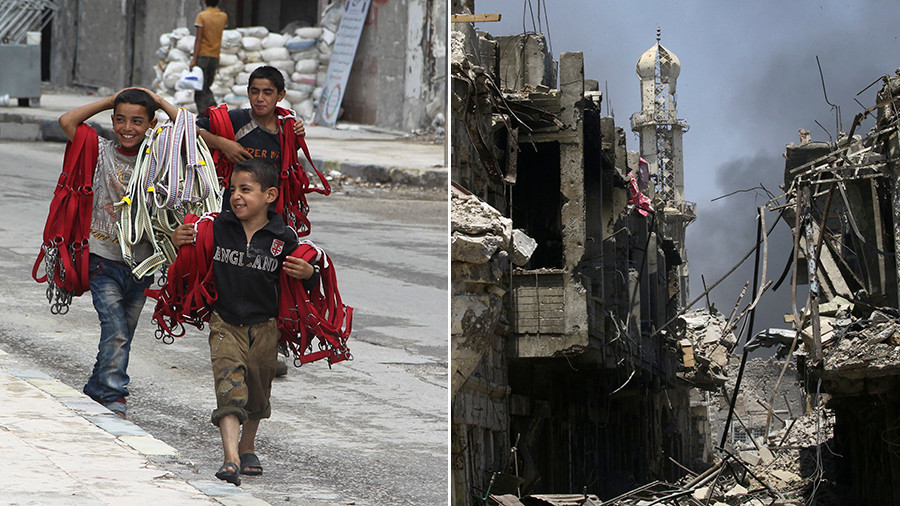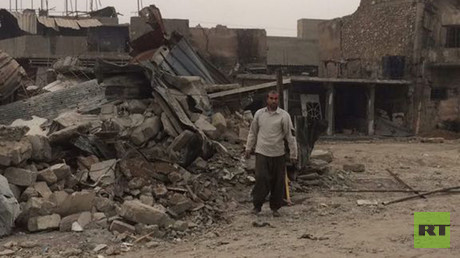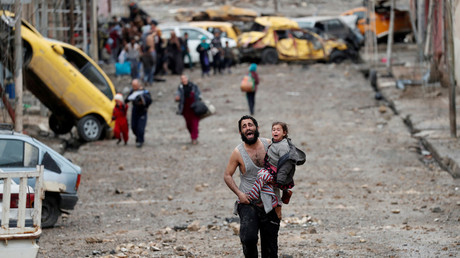A Christmas tale of two liberated cities, Aleppo & Mosul
Robert Bridge is an American writer and journalist. He is author of the book, 'Midnight in the American Empire,' released in 2013. robertvbridge@yahoo.com

As eyewitness reports emerge from these two war-torn cities, the humanitarian conditions in Aleppo appear to be stabilizing faster compared to Mosul. The US obsession with Syrian regime change appears to be the reason.
A scene best described as miraculous emerged from the Syrian city of Aleppo on Christmas Eve as hundreds of Christian Syrians took to the streets in celebration of the religious holiday.
Social media overflowed with pictures of children dressed up in Santa costumes, happily strolling the once fear-filled streets. Churches that months earlier had been targeted by Jabhat Al-Nusra and Islamic State militants were once again festive places of song and worship.
Beyond all odds, joy and celebration have conquered the atmosphere of fear and uncertainty that pervaded this city for many months during its captivity by IS forces. Even now, sporadic violence occasionally raises its head. Just days before the Christmas celebrations a neighborhood was shelled by anti-government forces. Two girls, age six and 13, were killed in the attacks.
In December 2016, after years of enduring a bitter siege, Aleppo was freed by the combined military forces of Syria, Russia, and Iran. Following the liberation, Russia was greeted with an outpouring of gratitude from the inhabitants of the city. And it certainly did not hurt Russia’s campaign that it provided a significant amount of humanitarian aid to citizens of Aleppo.
After the city was cleared of the rebel militants, the Russian Center for Reconciliation of Opposing Sides in Syria delivered nearly 35 tons of humanitarian aid – which included hot meals, food packages, warm clothes for children, blankets, and first aid - to the refugees of the al-Mahaledzh camp in eastern Aleppo. The importance of such assistance to people who have lost everything from the deprivations of war cannot be overestimated.
While the city will require many years of rebuilding, it looks as though the citizens of Aleppo have passed through the darkest hour of their plight. The same, however, cannot be said for their fellow war victims in Mosul, Iraq.
Not so merry Mosul
Judging by live, on-the-ground reporting from Mosul, this Iraqi city is not faring nearly as well as its Syrian counterpart. Liberated from Islamic State forces six months ago, much of the city remains uninhabitable following a nine-month siege by Iraqi troops supported by the US-led coalition.
An RT crew paid a visit to Mosul this month and what they found was not encouraging.
Many of those who have returned to the city (or never left) are forced to borrow money to feed their families. Others were filmed digging through the corpse-strewn, bomb-littered ruins to salvage material to sell, such as scrap metal.
One boy, aged 11, told the RT crew through tears that this was his daily task.
According to RT correspondent Murat Gazdiev, the ancient city has been turned into a “dead and miserable place,” where there is “more rubble than buildings.” Nevertheless, the residents of the city are beginning to return, but most often “not out of choice.”
They literally have nowhere else to go.
A middle-aged man, one of many people interviewed on the streets of Mosul, told RT: “My home is destroyed. My shop is destroyed. I’m borrowing money just to feed my family. I’m going to sell my car tomorrow to buy food. Why is it like this? Where are the countries that said they would support us?
The question is not an idle one. After all, it has been estimated that the US-led coalition forces spent tens of thousands of dollars per airstrike – hundreds and hundreds in the city of Mosul alone (The total cost for the US war in Syria and Iraq, from August 2014 to present, exceeds 14.3 billion US dollars, with a daily average of about 13.6 million).
The money from just a few airstrikes could feed all the civilians in this embattled Iraqi city for months. Yet the much-anticipated food shipments have not arrived, while residents are in a daily race against disease, dehydration, and starvation.
According to RT’s exclusive report, the local Mosul garrison, called ‘Division Five,’ shares its food with the locals, while some NGOs showed up and handed out blankets. But that has been the extent of the humanitarian assistance.
“The world has forgotten Mosul. It’s out of fashion, no longer trending. And locals have a well-founded suspicion that this was never about saving them,” Gazdiev commented.
Meanwhile, there are still some remnants of IS fighters left in the city, which makes the daily necessity of finding food and water even more of a challenge. Indeed, half a year after declaring the city liberated, the RT crew had to be escorted around the town by a soldier with his pistol always drawn and cocked.
At this point, there emerges an obvious question: Why the dramatic difference in conditions between these two places? Why does it seem that Aleppo is recovering not only at a much faster pace, but is also receiving a massive amount of humanitarian aid from Russia?
The answer, I believe, can be found in how both Russia and the US-led coalition approached their respective missions. First, Russia did not suddenly appear in Syria as an invader, as the United States did in Iraq in 2003 when it – wrongly - accused Saddam Hussein of harboring weapons of mass destruction. Syrian President Bashar Assad extended a formal invitation to President Putin to assist his country in routing the terrorist invader.
Second, it was arguably never the intention of the US-led coalition to eliminate Islamic State. This much was admitted in a 2012 Defense Intelligence Agency document released by Judicial Watch. The DIA predicted the rise of Islamic State, yet did not categorize the group as an enemy. In fact, it expressed outright support for the emergence of the group.
According to the report: “…There is the possibility of establishing a declared or undeclared Salafist Principality in eastern Syria (Hasaka and Der Zor), and this is exactly what the supporting powers to the opposition want, in order to isolate the Syrian regime…”
In other words, the US-led forces planned for their mercenaries to supplant Assad in Damascus.
This revelation seems to support the Russian Defense Ministry’s claim the US-backed forces in September were facilitating the safe retreat of ISIS fighters out of Iraq and into Syria.
“The US-led coalition, which is simulating the fight against ISIS, primarily in Iraq, sees all this but continues to supposedly actively fight against ISIS, for some reason in Syria,”saidMajor General Igor Konashenkov.
There is a strong temptation here to say the US-led forces, more concerned about moving its terrorist chess pieces to checkmate President Assad, were not remotely interested in improving the plight of Iraqi and Syrian citizens. Their sole and very cynical interest was gaining a strategic advantage in the region with the help of renegade militants.
All things considered, the dramatically different Christmas pictures coming out of Aleppo and Mosul points to precisely such a grim conclusion.
The people of Mosul are paying the price for such folly.



0 Comments:
Post a Comment
Subscribe to Post Comments [Atom]
<< Home